Episode 163
What you’ll learn in this episode:
- Why every art student should have business classes as part of their curriculum
- How the American mythology of the starving artist is more harmful than helpful
- Why it’s important to expand a creative business beyond just making
- How polymer clay went from craft supply to respected artistic medium
- Tips for entering jewelry and art exhibitions
About John Rose and Corliss Rose
2Roses is a collaboration of t Corliss Rose and John Lemieux Rose.
The studio, located in Southern California, is focused on producing one-of-a-kind and limited-edition adornment and objects d’art, and is well known for its use of a wide range of highly unorthodox materials.
The studio output is eclectic by design and often blended with an irreverent sense of humor. 2Roses designs are sold in 42 countries worldwide and are exhibited in major art institutions in the US, Europe, and China.
Photos:
Heart Brooch
Attending the Yuma Symposium caused this brooch. It is a “thing” at Yuma to do a second hand store crawl. There are many located all over the city, and well stocked because of the annual snow-bird influx. It has become kind of a game at the symposium to see who can scoop the best and weirdest deals. One year we stumbled into a shop that was unloading a huge inventory of “junk” jewelry by the kilo. We bought it all and promptly deconstructed the cache for parts. We were instantly in possession of more beads of every imaginable size, color, and shape than we would ever use in our lifetime. This brooch is the result of having more beads than you know what to do with…and because everybody likes hearts.
Beads, resin, sterling silver.
4 inch H
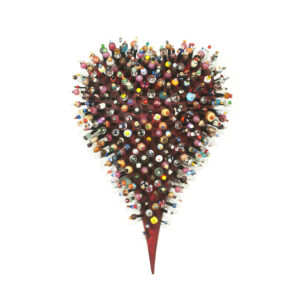
We Ran Off and Joined the Circus Bracelet
Art Jewelry is often about a narrative. This bracelet is part of a series that we created to express our real-life experiences. In this instance, we really did run off and join a circus at one point in our lives. It was every bit as strange and exotic as you might imagine.
Polymer clay, sterling silver
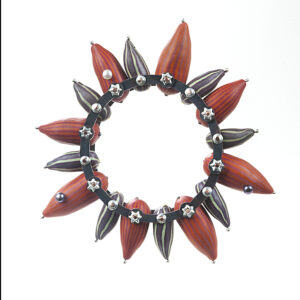
Mojave Bouquet Brooch
We spend considerable time in the deserts of the American Southwest and Northern Mexico. Pieces that interpret that landscape have been a recurring theme throughout our careers.
Corlite, sterling silver
3 inch H
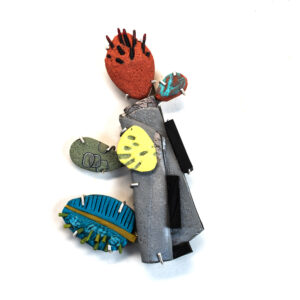
HiTek Mosaic Necklace
As technology entrepreneurs, we have deep connections with many industrial sectors. This has afforded us access to a mind-boggling array of odd materials that have crept into our jewelry. Our HiTech series exposes the beauty hidden in the technology that we are literally surrounded by, but often never see.
Electronic components, 18kt gold, sterling silver
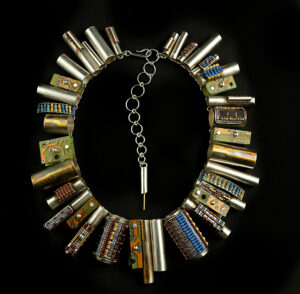
Big Green Brooch
This is another in the series of objects that express our direct real-life experiences. This brooch is related to Corliss’s growing up in a floral shop and designing corsages from an early age.
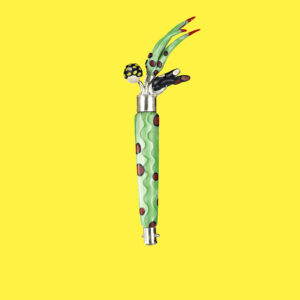
Additional Resources:
Transcript:
For John and Corliss Rose, business and artistic expression don’t have to be in conflict. Entering the art world through apprenticeships, they learned early on that with a little business sense, they didn’t need to be starving artists. Now as the collaborators behind the design studio 2Roses (one of several creative businesses they share), John and Corliss produce one-of-a-kind art jewelry made of polymer clay, computer chips, and other odd material. They joined the Jewelry Journey Podcast to talk about their efforts to get business classes included in art school curriculum; why polymer clay jewelry has grown in popularity; and how they balance business with their artistic vision. Read the episode transcript here.
Sharon: Hello, everyone. Welcome to the Jewelry Journey Podcast. This is a two-part Jewelry Journey Podcast. Please make sure you subscribe so you can hear part two as soon as it comes out later this week.
Today my guests are designers John and Corliss Rose of the eclectic design firm 2Roses, located in Southern California. They sell worldwide. 2Roses is an award-winning design firm recognized for their use of unusual materials. Today we’ll hear more about their jewelry journey. Corliss and John, welcome to the program.
John: Thank you. It’s a delight to be here. Thank you very much.
Sharon: So glad to have you. Tell us about your jewelry journey. Were you designers first? How did that work?
John: Actually, we both started rather early in life. Corliss started as an apprentice in her father’s floral store when she was 10, and I was apprenticed into design and graphic arts at age 12. We both came up in the old-school apprentice system and were working professionally by our early teen. It wasn’t until later, in our late teens, that we both started professional or, I should say, a traditional academic trend. So, we’ve always been in the arts, both of us, very early.
Sharon: Were you both attracted to jewelry early as part of this? Where did that come in?
Corliss: We met at art school, and our backgrounds and our career focus on developing a creative career were almost identical, so we hit it off right from the get-go. For the first 10 years of our relationship, we focused on our own individual creative paths, but we kept intersecting with each other. Eventually we made the decision to work together full time collaboratively for a creative endeavor. Jewelry, at that moment in time, was the highlight of where we wanted to focus our energies.
Sharon: Is that when you met, when you were both part of the apprenticeship, or when you were in college? Where did you meet?
Corliss: We met in art school in Chicago.
John: Prior to that, we had quite a bit of time to develop different practices and careers. So, we met midway, I suppose, in our journey.
Sharon: When you say you were apprenticed, was the idea that you would learn how to be a designer, how to be a florist, and that’s what you were going to do?
Corliss: At that time, I was being groomed to take over my father’s business. I learned not only the design aspect, but at a very early age, I learned cost accounting. I was learning the business aspect of it. I was pretty much indoctrinated from the very beginning that you’re going to be an artist, but you’re not going to be a starving artist. You need to make a profit out of this so you can flourish. Later on in my career, I had one gallery owner tell me that the work was wonderful, but price it this way because it’s one thing to make your bread; it’s another thing to put butter on it. So, it was something that I had gotten all along.
Sharon: Wow! Most people don’t get that so early, so that’s great.
John: All of the apprenticeships I did, it was all about how this is a business first, and we do creative things like manufacturing a product. So by the time we hit formal arts school, when we first met, we very quickly realized that we had a mutual experience of understanding of the art world and our career path. That’s what was a very strong attraction; that we both looked at this as a business career. This isn’t about abstract ideas of, “Let’s be creative,” and all the mythologies that artists are inculcated with. We didn’t seem to have that kind of thinking.
Sharon: Were you ahead of your peers in that respect? Were you ahead of your peers because you recognized the business aspect?
John: Oh my god, yes. Yeah, it was really like that. By the time we hit college, most of our peers were just starting out. They were just starting to learn their career paths and trying to figure out what they were doing. We already had several businesses going. For us, the academic training was more of a cherry on the cake and polishing skills. By that time, we were working professionals and had been for quite some time.
Sharon: Wow! Tell us about the jewelry you make. We’ll have pictures when we post the podcast, but it’s so unusual.
Corliss: We’ve always been driven by exploration and experimentation with what we call odd media. This is what drew us to art jewelry in the early days. It was like the wild west. Anything went, and we just threw out all the rules of traditional jewelry. Fashion and adornment were being challenged at that time. It was almost like a golden age, where there was a lot of free-flowing ideas, a lot of collaboration with John and me, and a lot of fluid dialogue creatively between the both of us.
John: You asked about jewelry, and one of the things is we didn’t start out as jewelers. Both of us came to it through a lot of other mediums. Myself, I started out as a painter, illustrator, furniture maker, gem cutter, sign maker, designer of one thing or another, machinery. Corliss went through all sorts of other endeavors herself.
Corliss: It was basically when we had been together for 10 years, plus doing all of these interesting things, that we made the decision, “Jewelry would be a great direction to go into.” And just to pull the curtain back a little bit and give a peak, I think one of the nicest things that happened to me at that time was that as an anniversary gift, I received lessons for metalsmithing. I learned how to solder, and that was the beginning of it. What I learned, I taught John. We experimented with a lot of different processes and a lot of different materials, and it just started to take off from there.
Sharon: When you say metalsmithing, I would think you would go in the traditional direction, whereas you took the metalsmithing and combined it with polymer clay, it seems, which people don’t do. I’m looking at what your website has, and that’s unusual. How did you reverse course in a sense?
Corliss: We were very much interested in color. At that time, we were following the traditional path of experimenting with color and its relationship to metals: patinas,P Prismacolor pencils, enamels and things like that. Polymer clay was such a versatile material. It could mimic just about anything. At the time, the product was being developed in Europe, where it was originally manufactured, and there was a small group of people using the product and doing some pretty innovative things with it. I latched onto that train very, very quickly and took myself through the learning curve of how to work with it, and I got involved with that particular community for quite a while to absorb everything I could, like a big, old sponge. To this day, it plays a very vital role in a lot of work we do. Because we have been metalsmiths and I teach, I have been able to actually teach the incorporation of some of the simpler metalsmithing techniques with polymer to people who have only worked with polymer and opened up that door to them. It’s been very rewarding in that respect.
John: You made a good observation about that crossover because as Corliss mentions, it’s really a two-way street. What we recognized after a while is that introducing polymer clay to the metal world was one side of the sword, and then it was basically introducing metals into the polymer world. Corliss has developed a whole range of courses, workshops, if you will, going in both directions, and that’s become a business unto itself.
Sharon: You seem very entrepreneurial. You seem to go on and on.
Corliss: As John would say, there are many paths to the artist’s income.
John: Yeah, entrepreneurialism is really baked into the DNA. I have to go back to the apprenticeships that we both did that gave us a foundation in—I always express it as art as a business and business as an art.
Corliss: It was a work ethic, too.
John: Yeah. So, we tend to always look at what the business opportunities are, how to make money doing this. That’s always an issue for anybody in the arts, and that’s also part of what we have advocated for for the last 40 years. I have worked with the California University system for decades trying to introduce a business curriculum into the arts, and it’s taken 40 years to actually get that message across. It’s only been in the last 10 years that we’ve started getting any kind of acceptance. We’ve developed many programs for various universities to teach the business side of art, and it’s been an obstacle course to get that through. It runs counter—or at least it used to run much more counter to the academic approach to teaching arts, which focuses more on technique than actually earning a living.
Corliss: I’ve had quite a few experiences with individuals who were poised for graduation in the next six months or so. We would have conversations about, “I don’t know what I’m going to do next. I’m going to graduate, but I don’t know how to start a business. I was never taught how to make this a practice.” That’s where everything started. It started by recognizing that there is a need for it within the education system. It led to developing more and more sophisticated ways of instructing people and getting them a little more prepared for what comes after graduation.
John: The thing we found, though, is that this is a uniquely American perspective. We’ve developed programs for Canada, for Mexico, South America, and they embraced them. To them it’s a no-brainer. It’s only America where we’ve encountered any resistance to it.
Sharon: Interesting. Why do you think that is?
John: I think a lot of it is the mythology of art. I want to be specific about this. We are focusing on metals programs and jewelry design programs for this kind of thing. When I was involved in SNAG, we got into this quite in-depth. One of the biggest impediments is that the instructor basically had never operated a business himself, so to them, they were being asked to teach something they had no experience in. Basically, they got their master’s degree, and they went from being students to teachers. That’s it. The idea that there was another world out there, they would say, “Yeah, that’s great. That would be wonderful, but that’s not something I have any experience with.”
Sharon: That’s interesting, the idea that art should be pure and sell itself.
John: That’s one of the mythologies, so Puritan. It’s your labor, I guess. One of the things that occurs to me: many people in the arts define themselves by what they do with their hands, and we have never done that. We conceive the opportunities of who we are by what we do with our minds and how we harness our creativity and create opportunities for ourselves to express that creativity. Jewelry is just one of those things. We have a long history in developing businesses, which goes back to the apprenticeships. From our perspective, it’s all creative endeavor.
Corliss: I was a pastry chef.
Sharon: Wow!
John: A television pastry chef, no less
Corliss: Yes.
John: And she basically made formulations for a lot of very famous restaurants and product lines that you would know of.
Corliss: Making the croissants for Marie Callender’s. Looked up the recipe for that.
Sharon: Wow!
John: That’s Marie right there.
Sharon: How did all this meld into jewelry? I know you through Art Jewelry Forum. I know you do art jewelry, but how did everything you’re talking about meld, at one point, into art jewelry? I know you do a lot of other different things, but in terms of the product, let’s say.
John: We were both active artists in various spheres. One of the things we were doing a lot was running mining and prospecting operations. We were accumulating massive amounts of gem material, and it came to the point where we had to make a decision of what the hell we were going to do with all this stuff. That’s when we came upon jewelry. We could either sell the material wholesale, which we were doing, but really the profitability in jewelry is that we had to finish the faceted stone and polish the rough material. You get the material by the pound, but you sell it by the carat.
Corliss: It was lapidary skills that was the predecessor to this. We were making cabochons. John was faceting and we were also carving. We were carving a lot of natural materials, like bone and wood. The jewelry morphed from that, and it started selling. I was actually schlepping things in a big case, and we found that our work was being very well received. It grew and built from that. Soon enough, we were incorporating precious metal into our pieces.
John: We started doing more of what I would call conventional jewelry, and we had quite a success doing that. Early on, we got contracts with Neiman Marcus and Nordstrom and some larger chains, and very quickly we found out that doing that kind of work is not what we wanted to do.
Corliss: Yes, multiples.
John: Like doing 5,000 of something. You can make money, but the toll that takes on your body—I know a lot of people that do that, and all of them have wrist problems. It leads to health problems. So, that kind of jewelry was when we were getting started and taking off.
When we discovered art jewelry, we lost our minds. It was the wild west. It was all of our art training, all of the things we thought of ourselves as, what we wanted to do in terms of unfettered creativity and experimentation, pushing the boundaries and the edge. That’s what was happening in art jewelry. So, we said, “Yeah, that’s where we want to go. If we’re going to do jewelry, that’s the kind of stuff we’re going to do.” That’s basically how we backed into this world.
Corliss: That’s how it opened us up to a lot of different materials. We were in the frame of mind of purposely going out and looking for materials in a lot of different places, everything from upcycling to computer boards and things of that sort, a whole variety of things. We had friends who would tease us and bring us little offerings we could use in the studio and comment, “You two can make something out of anything.” We took that as a wonderful compliment and put ourselves in a position to receive a lot of very interesting material we could use.
John: Well, we had good circumstances and still do because of all these other businesses we were involved with. We had connections within the military, NASA, foreign governments, lights and heavy manufacturing, the medical industry. We were getting access to this insane array of stuff and materials. I’ve got stuff from someone’s space capsule, a jet fighter, fossils of every kind, medical devices you wouldn’t normally get your hands on. All of this became fodder for “Let’s make jewelry out of it.” One example: I have what we call the world’s most expensive pair of earrings. One of my contacts ran a medical manufacturing business, and they spent something like $35 million developing these little—
Corliss: Chips.
John: Yeah, for CAT scanners, and they failed. They didn’t work as intended. So we stocked six of these prototypes, which literally cost $35 million, and they were like, “Well, we can’t use them. Here, make some jewelry out of them,” which we did. We made earrings out of them, and I love that particular piece. It has a story because they went from being extravagantly expensive to being completely worthless, and now they’re a pair of earrings. Somebody put some sort of value on it, I guess.
Sharon: It sounds like people who know you just ship you boxes and bones and screws and whatever they have.
John: We receive regular offerings from friends, which is a delight; it really is. Over the years, we’ve developed a solid foundation of collectors. We get a steady stream of commissions, and it’s very typical to hear, “I have this thing. Can it be—” I mean, we’ve gotten everything from antiquities—
Corliss: We have Roman coins and special pottery shards.
John: And crazy stuff that people say. “Here, use this as the starting point and make me something.” We actually got a guy’s pacemaker one time. “I’ve had this inside of me for the last six years, and now I’m going to wear it on the outside.”
Sharon: That’s an interesting idea.
John: It was quite an interesting piece.

